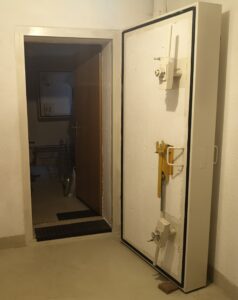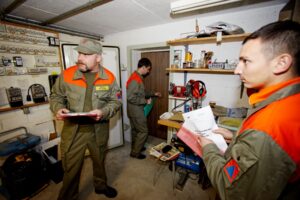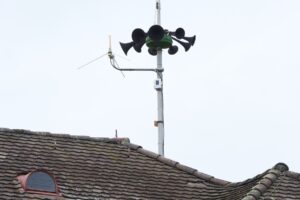Fallout shelters and emergency management in Switzerland
Switzerland is the only country in the world that has fallout shelters capable of accommodating the entire population in case of emergency

Bomb shelters began to be built as a result of the spread of nuclear weapons. Especially during the Cold War in many countries, including the Swiss Confederation, their construction became mandatory.
This room is normally used as a cellar, hobby room, tavern, sauna, storage room, but it is equipped with a thick armored door with a ventilation system, completed by a gas filter, able to accommodate the inhabitants of the house or condominium and even protect them in case of nuclear attack.
The Civil Protection, through periodic monitoring campaigns ensures that the shelters are maintained in good condition. The private bunkers must have working ventilation and beds and in case of emergency must be ready within five days at most.

E’ assolutamente vietato eseguire modifiche strutturali o ristrutturazioni non autorizzate e sono previste sanzioni fino a 5000 franchi nonchè l’avvio di una procedura per abuso edilizio per le infrazioni. La possibilità di sopprimere un rifugio viene concessa unicamente per ragioni inderogabili, quali la costruzione di un ascensore o di una caldaia.
La legge federale sulla protezione della popolazione e della protezione civile recita che ogni abitante deve disporre di un posto protetto per questo gli edifici costruiti a partire dagli anni ’60 sono dotati un rifugio.
Oggi in Svizzera ci sono circa 360000 bunker costruiti in case, istituti, ospedali, a cui si aggiungono circa 5000 rifugi pubblici, con un grado di copertura che supera addirittura il 100% della popolazione.
Nel 2012 la legge federale prevede l’obbligo di costruire rifugi solo nei nuovi edifici con più di 38 locali o in quei comuni dove non ci sono posti protetti a sufficienza, per cui oggi raramente i privati costruiscono nuovi bunker e preferiscono pagare una quota annuale al cantone per ogni posto non costruito o soppresso “guadagnando” quindi spazio per esigenze personali. In compenso sono stati costruiti più rifugi pubblici.

Atomic shelters in the world
In Europe, only Sweden, which can accommodate about 80% of the population, and Finland, which can cover about 70%, are adequately organized.
The other European countries are not at all ready in this sense: Austria for example, is able to accommodate a maximum of 30% of the population and most of the shelters are not equipped with a ventilation system, while Germany covers only 3% of the population.
Looking at non-European countries, these types of structures are very common in China, South Korea and Singapore, however coverage rates never exceed 50%.
Israel has shelters that are not completely waterproof and can only accommodate two-thirds of the population.
Sonnenberg Highway Tunnel
In Lucerne, there was the largest civil defense structure in the world in which up to 20,000 people could find shelter: the Sonnenberg Tunnel.
This structure was opened in 1976 and the seven floors above this tunnel also contained a hospital, an operating room and a radio studio. It was then dismantled in 2006 and an area capable of accommodating about 2,000 people was maintained.
The doors of this shelter, 1.5 meters thick and weighing 350,000 kilos, could withstand an explosion within a kilometer of a one-megaton atomic bomb.
This tunnel was used in 1999, to accommodate some inhabitants of the Goms valley (Canton Valais), affected by floods.
Abolition of the obligation to build shelters
In Switzerland, in 2005, the then National Councillor Pierre Kohler presented a parliamentary initiative that called for the abolition of the obligation to build shelters in private homes, highlighting the uselessness of the shelters and the fact that they put an excessive burden on the construction price of houses.
The government, however, came to the conclusion that they are still useful, not only in case of armed conflict, but also to cope with any terrorist attacks with nuclear weapons, chemical accidents or natural disasters.
Norway, on the other hand, repealed the requirement for bunkers in 1998.
Sirens and Alertswiss App
In the Swiss Confederation a total of about 7200 fixed and mobile sirens are positioned.
Every first Wednesday in February, the annual siren test takes place throughout Switzerland. On this occasion, both the sirens for the general alarm and those for the water alarm are tested.

In addition to the alarm system via sirens and radio information, there are the services of Alertswiss.
On the alertswiss website you will find all relevant information about preparations and correct behavior in case of disasters and emergency situations.
Citizens are also urged to use the new alert and information channels and to install the free Alertswiss app on their smartphones. The app is available for Android and iOS systems and can be downloaded from Google Play Store and Apple’s App Store .
This app allows you to receive alerts, warnings and information about a variety of hazards directly to your smartphone.
Iodine tablets

In Switzerland, at locations within a 50 km radius of a nuclear power plant, iodine tablets are distributed to the resident population as a precautionary measure to prevent radioactive iodine from accumulating in the thyroid gland and causing thyroid cancer.
For locations located beyond 50 km, the cantons store stocks to be distributed to the population in case of need.





